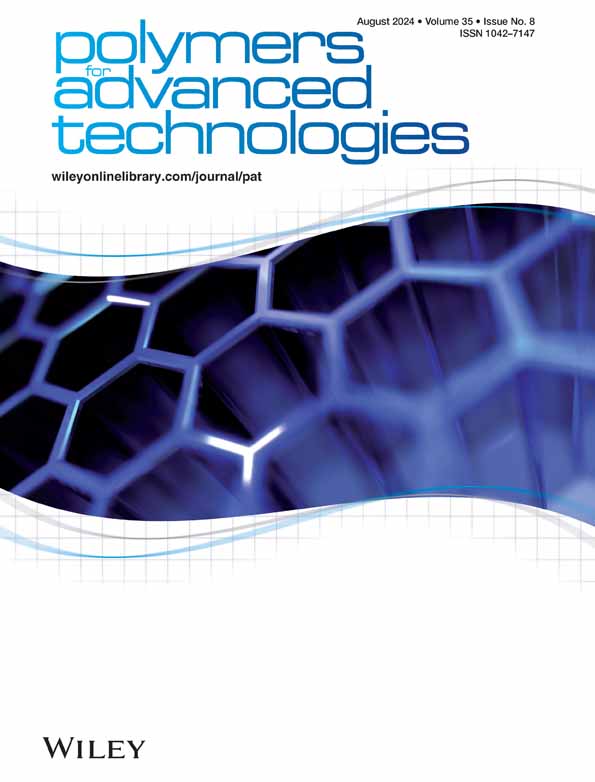用芯壳橡胶颗粒操纵新型环氧基复合材料,设计铝-铝粘接接头的结构粘合剂
IF 3.4
4区 工程技术
Q2 POLYMER SCIENCE
引用次数: 0
摘要
环氧树脂粘合剂由于交联度高,固化后会变得非常脆。为了提高环氧树脂粘合剂的韧性,有人建议添加不同的增韧剂。在这项研究中,双酚 A 的二缩水甘油醚(DGEBA)/双氰胺环氧网络通过添加含有通过种子乳液聚合法制备的核壳橡胶粒子(CSPs)的乳液胶乳进行了改性。CSP 由作为芯的聚丙烯酸丁酯(PBA)和与甲基丙烯酸缩水甘油酯(GMA)共聚的甲基丙烯酸甲酯(MMA)作为壳组成。研究了添加不同量的乳液胶乳对固化环氧树脂的机械性能、热稳定性、附着力和微观结构的影响。透射电子显微镜(TEM)、傅立叶变换红外光谱(FTIR)和差示扫描量热法(DSC)对 CSP 进行了分析。应力应变、热重分析(TGA)、单圈剪切试验和场发射扫描电子显微镜(FESEM)分别研究了固化环氧树脂的机械性能、热稳定性、与铝板的粘附性和微观结构。与纯环氧树脂相比,在环氧树脂中添加 7 wt.% 的乳液胶乳可使哑铃形样品的拉伸强度和韧性分别提高 421% 和 4388%。此外,在不影响最高分解温度的情况下,添加 7 wt.% 的 CSP 使环氧树脂的单圈剪切强度提高了 33%,初始分解温度提高了 71°C。断裂表面的 FESEM 显微照片表明,主要的增韧机制是 CSP 脱粘结、塑性空隙增长和剪切粘结屈服。本文章由计算机程序翻译,如有差异,请以英文原文为准。
Manipulating a novel epoxy‐based composite with core–shell rubber particles for designing a structural adhesive in aluminum–aluminum bonded joints
Epoxy adhesives become very brittle after curing due to their high‐crosslinking degree. For increasing the toughness of epoxy adhesives, the addition of different toughening agents has been proposed. In this study the diglycidyl ether of bisphenol A (DGEBA)/dicyandiamide epoxy network has been modified by adding an emulsion latex containing core–shell rubber particles (CSPs) prepared by means of seeded emulsion polymerization. The CSPs consist of poly (butyl acrylate) (PBA) as core and methyl methacrylate (MMA) copolymerized with glycidyl methacrylate (GMA) as shell. The effects of adding various amounts of the emulsion latex on the mechanical properties, thermal stability, adhesion, and microstructure of the cured epoxy resin were investigated. The CSPs were analyzed by transmission electron microscopy (TEM), Fourier‐transform infrared spectroscopy (FTIR), and differential scanning calorimetry (DSC). The mechanical properties, thermal stability, adhesion to aluminum plates, and microstructure of the cured epoxy resin were investigated by stress–strain, thermal gravimetric analysis (TGA), single lap shear test, and field emission scanning electron microscopy (FESEM), respectively. The addition of 7 wt.% emulsion latex to epoxy enhanced the tensile strength and the toughness of the dumbbell‐shaped samples by 421% and 4388% with respect to neat epoxy, respectively. Furthermore, the single lap shear strength increased in 33% and an increase of 71°C in the initial decomposition temperature of the epoxy was obtained by adding 7 wt.% CSP, without affecting the maximum decomposition temperature. The FESEM micrographs of the fractured surfaces indicated that the major toughening mechanisms were CSP de‐bonding, plastic void growth, and shear bond yielding.
求助全文
通过发布文献求助,成功后即可免费获取论文全文。
去求助
来源期刊

Polymers for Advanced Technologies
工程技术-高分子科学
CiteScore
6.20
自引率
5.90%
发文量
337
审稿时长
2.1 months
期刊介绍:
Polymers for Advanced Technologies is published in response to recent significant changes in the patterns of materials research and development. Worldwide attention has been focused on the critical importance of materials in the creation of new devices and systems. It is now recognized that materials are often the limiting factor in bringing a new technical concept to fruition and that polymers are often the materials of choice in these demanding applications. A significant portion of the polymer research ongoing in the world is directly or indirectly related to the solution of complex, interdisciplinary problems whose successful resolution is necessary for achievement of broad system objectives.
Polymers for Advanced Technologies is focused to the interest of scientists and engineers from academia and industry who are participating in these new areas of polymer research and development. It is the intent of this journal to impact the polymer related advanced technologies to meet the challenge of the twenty-first century.
Polymers for Advanced Technologies aims at encouraging innovation, invention, imagination and creativity by providing a broad interdisciplinary platform for the presentation of new research and development concepts, theories and results which reflect the changing image and pace of modern polymer science and technology.
Polymers for Advanced Technologies aims at becoming the central organ of the new multi-disciplinary polymer oriented materials science of the highest scientific standards. It will publish original research papers on finished studies; communications limited to five typewritten pages plus three illustrations, containing experimental details; review articles of up to 40 pages; letters to the editor and book reviews. Review articles will normally be published by invitation. The Editor-in-Chief welcomes suggestions for reviews.
 求助内容:
求助内容: 应助结果提醒方式:
应助结果提醒方式:


